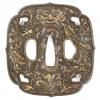Hi guys, I'm now the proud owner of this set that is the subject of this thread. I'm not a Japanese sword collector per sé, I only own a small number of Japanese arms.
The set appeals to me because I am mostly a Chinese sword collector and researcher. The style exhibited on the handles of this set is a close match to the sword mountings of the early Manchu nobility, even before they set out to conquer China from the Ming dynasty in the mid 16th century. One of the textbook examples of this style is the saber of Hong Taiji who lived between 1592-1643. Such sabers are extremely rare in Western collections, which is why not many people immediately draw the link to early Qing imperial mountings and nanban tsuba. For most, quality is not the first that springs to one's mind when thinking about Chinese swords. The Hermitage in St. Petersburg has an impressive collection of such sabers -not on view- and the Metrpopolitan Museum owns one. The style derives off Tibetan saddle mountings, and in the decades before the Manchus set out to take over China they forged alliances with Mongol tribes. From letter exchanges between Manchus and Mongols of this time we gather that part of the tribute were "carved saddles", most likely Tibetan imports. The Tibetans didn't use sword guards anyting like the Japanese or Chinese, but I think they were the ones that started to produce the first sword fittings in this style, made to be mounted on Chinese sabers. The first of these made it to Japan mainly through trade, probably from the late 16th century onwards and became the prototype for that since the 20th century got known as "nanban tsuba". (This is the typical Canton style. In China the style was mostly found in Beijing were imperial craftsmen made them from the 17th century onwards, but it was through Canton (Guangzhou) that they spread through Asia, including Japan.) I agree with Peter Bleed in that by far most of these are Edo period, and these late designs usually follow one of various standardized concepts. There are however quite some very interesting earlier guards, some of which most certainly imported into Japan and modified for Japanese use. Others were made abroad with export to Japan in mind from the start, including hitsu-ana, sometimes not well-cut by a craftsman ignorant of Japanese sword culture. This also explains the wide range of odd seppa-dai, some of which copied in Japan, by Japanese craftsmen, for the sake of an exotic look. This set seems earlier to me, possibly made to match an import guard. Its importance lies in that it's the only known matches set of its type I know to be in existence, and it may well date from the Ming-Qing transition period of the 17th century.
This is fascinating! I would love to examine these. I'm having a hard time finding them in their current online database. Do you happen to have an accession number? Peter



